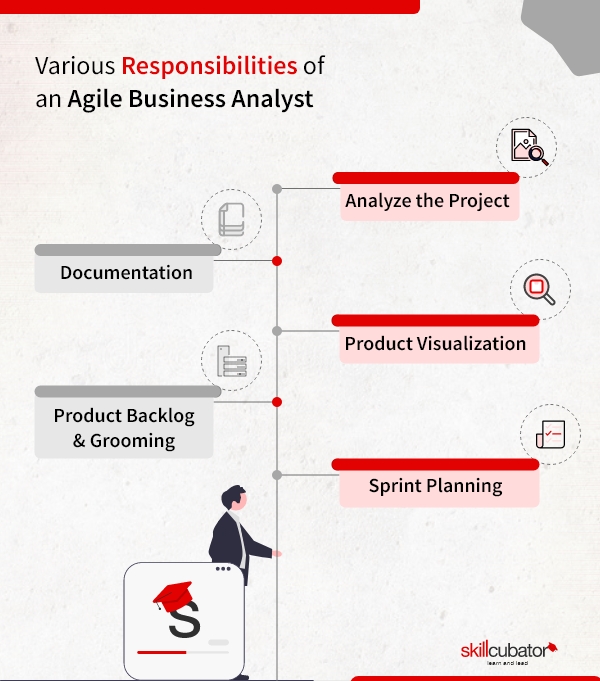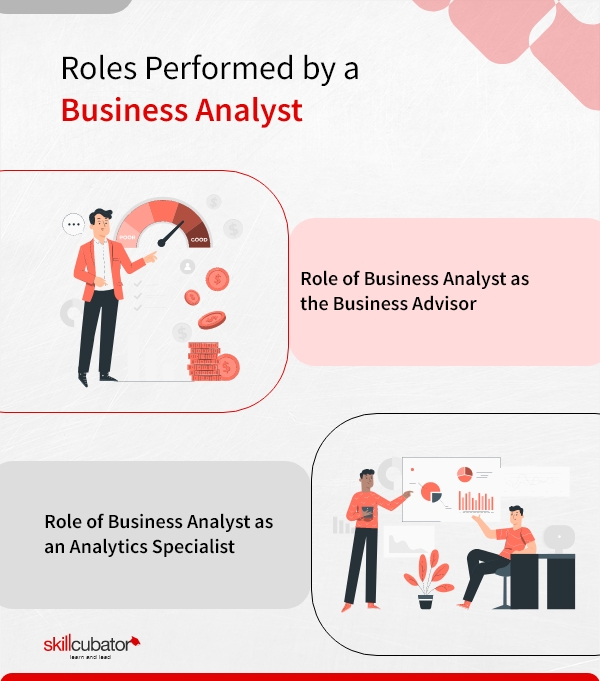Steps to Build a Career as an Agile Business Analyst
One of the keys to the success of a software development project is the existence of a business analyst in an agile team. Professionals with analytical skills to understand, visualize and analyze are highly sought after for handling software-based projects.
With a set of analytical capabilities, you’ll be able to understand the domain, requirements, process, product, and end-goal. When kickstarting your career as a business analyst in an agile environment or when your current organization migrates to agile, you’ll have many questions.
This blog will give you a basic understanding of what is the role of an agile business analyst? By the end of the blog, you’ll get answers to all your queries and will look forward to taking the next move in your career path.
Without any further ado, let’s dive right in.
[ez-toc]
1. Traditional vs. Agile Business Analysis. Which is Better?
Traditional business analysis uses conventional tools and techniques, to solve the problem and build a solution as per stakeholders needs and requirements, with heavy focus on upfront requirements elicitation, analysis, and documentation.
Whereas Agile business analysis focuses on building flexibility to the changing requirements, reducing time-to-market and customer feedback much early in the process.
2. What does an Agile Business Analyst do?
An agile business analyst is a business analyst who works on software development projects using agile methodologies.
An agile software development team involves,
– Product Owner
– Agile Business Analyst
– Solution Architect
– Scrum Master
– UI/UX Consultant
– Developers
– Quality Analyst
The Process
A stakeholder reaches the agile team to resolve a business issue. The team inspects the issue to find a solution. Once the inspection is carried out, the aspects of the problems are documented into logical deliverable stories.
After this, user stories from customers’ perspectives are written. Then, the agile business analyst comes in to review these stories, break into small sprints, set priorities along with the product owner, and works with the development team to build a solution.
3. Skills Required to Become an Agile Business Analyst
Agile business analysts are professionals who provide business analysis services in an agile software development framework. They work closely with the product owner, development team, and stakeholders to meet the objective.
Communication Skills
Proper communication is half the percent success of a project. Agile business analysts should communicate with every team member and make everyone understand the stakeholder’s requirements, concerns, and objectives of the project. They are the bridge connecting the team and stakeholders. So, they require effective communication skills.
Therefore, when you become an agile business analyst, you should feel free to communicate face-to-face, over the phone, by mail, or any channel.
Business Domain Expertise
An agile business analyst is the “go-to” member for both the development team and stakeholders, so he/she needs to have a complete understanding of the business, product, and objectives. Along with business and product expertise, the analyst should be capable of understanding and prioritizing business values as well.
As an agile business analyst, you should use business domain knowledge to identify relevant concepts and relationships. Then, use your analytical skills to think about how to solve business problems.
Technical Knowledge
The tools and techniques in agile methodology effectively help in handling backlog management, real-time collaboration, estimates, reports for sprints and deliverables, etc. To become a successful agile business analyst, it’s crucial to have a good understanding of the different tools and techniques available in agile methodology.
Good Thought Process
Typically, agile teams are cross-functional and self-organizing, so when you become an agile business analyst, you should look from different perspectives and come up with the best possible ideas to achieve the desired outcome. Also, it’s usual that there will be changes in the requirements, so youshould be flexible to adapt to those changes as well.
Problem-solving
An agile business analyst should hold problem-solving capabilities. Few problems are solved in the very first attempt. However, few take multiple iterations.
It’s imperative for a business analyst to converse with team members and stakeholders to know the underlying reasons for major & minor problems and how to get rid of these.
4. Various Responsibilities of an Agile Business Analyst
An agile business analytics methodology towards solving a problem will empower the analyst to break down a big problem and then solve the small sprints. There are a few crucial responsibilities for an agile business analyst which we’ve listed down.

Analyze the Project
An agile business analyst should have the domain knowledge to closely examine every small to big detail in the project. Only then, the analyst will be able to work with the development team to understand the challenges, duration, dependencies, and so on.
The analyst mainly aims at assisting the agile team and product owner to analyze the business domain thoroughly. When you become an agile business analyst, you should thoroughly understand the project requirements and objectives. Only after that, you can advise the stakeholders on how the agile methodology can help in achieving the set goals.
Documentation
An agile business analyst is like a business advisor, who discusses with stakeholders to understand their product requirements. As a business analyst, you’re solely accountable for transferring the requirements to team members. Not only that, you should also make them precisely understand the primary objective.
Documentation keeps everyone on track, so you must be able to effectively document the processes involved in the software development lifecycle, including requirements, design, testing, and deployment phases.
Product Visualization
Product visualization is an important responsibility an agile business analyst should hold. Having a solution for a problem in mind will be challenging to describe the same to the team. Therefore, visual representation of the solution will help everyone understand the solution better.
Here, we’ve listed a few diagram types used for representing business analysis solutions.
– Data Flow Diagram (System Context Diagram)
– Use Case Diagram
– Class Diagram
– Entity Relationship Diagram
– Sequence Diagram
– Collaboration Diagram
Product Backlog & Grooming
As you become an agile business analyst, you should ensure that all the product backlogs are well-groomed. And also, make sure the user stories are properly documented and ready for transfers.
User stories are the list of features derived for the customers of the end product. The business analyst supports the product owner in deriving stories from models created during domain analysis.
To stock the product backlog, a business analyst works with the product owner to identify and prioritize the features that need to be developed.
With a complete understanding of the business purpose and prioritizing the user stories, a business analyst like you, will help the team groom product backlogs.
You should also work with the product owner to ensure that the backlog items accurately reflect the business requirements. In addition, you may need to provide inputs on how the product should be developed to meet the business needs.
Sprint Planning
The agile business analyst is accountable for splitting the projects into sprints and refining the backlogs. The user stories should be clearly communicated to the development team, so they understand what they’re working on.
5. Roles Performed by a Business Analyst

Role of Business Analyst as the Business Advisor
In an agile environment, the product owner is the decision-maker. However, the product owner may not have the knowledge of analyzing the business domain, stocking, and grooming the product backlogs. On that scale, the agile business analyst will act as the business advisor and assist the product owner in decision-making.
As a business analyst in an agile team, you’ll work closely with the product owner by communicating instead of just creating documents to define the processes.
Role of Business Analyst as an SME
During iterations, the business analyst will serve as the analytics specialist for the agile team. Facilitating collaboration, generating examples, and transferring knowledge are the activities performed by the business analyst as a specialist.
6. What can be the Salary Expectation of an Agile Business Analyst?
According to Glassdoor 2022 reports, the pay of an agile business analyst on an average per annum.
- India – ₹7,45,000/year
- USA – USD 80,788/year
- UK – £50,022/year
- Canada – CAD 72,706/year
- Australia – A$ 1,00,000/year
- Germany – 54,699/year
- Italy – €29,000/ year
We’ve taken the details from the Glassdoor website, this is not the actual range, just an average. Depending on your location, the package may differ.
The Next Move
Since agile business analysis is a change-driven approach, it will enable you to deliver desired outcomes quickly and without quality compromises.
To build a successful career as an agile business analyst, the best approach is to register for an agile business analyst course. At Skillcubator, we’re offering certifications & courses accessible both offline & online exclusively for professionals aspiring to become an agile business analyst.
Interested to enroll in our agile business analyst certification, all you’ve to do is, drop us a message or give us a call at 17032009921. Our expert trainers will make you evolve as an agile business analyst.
